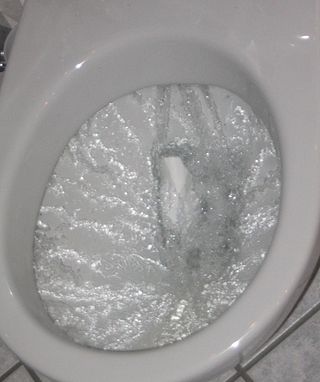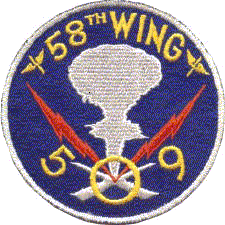
Paul Warfield Tibbets Jr. was a brigadier general in the United States Air Force. He is best known as the aircraft captain who flew the B-29 Superfortress known as the Enola Gay when it dropped a Little Boy, the first of two atomic bombs used in warfare, on the Japanese city of Hiroshima.

Straight Flush was the name of a B-29 Superfortress that participated in the atomic bomb attack on Hiroshima on August 6, 1945.

Wendover Air Force Base is a former United States Air Force base in Utah now known as Wendover Airport. During World War II, it was a training base for B-17 and B-24 bomber crews. It was the training site of the 509th Composite Group, the B-29 unit that carried out the atomic bombings of Hiroshima and Nagasaki.

Walker Air Force Base is a closed United States Air Force base located three miles (5 km) south of the central business district of Roswell, New Mexico. It was opened in 1941 as an Army Air Corps flying school and was active during World War II and the postwar era as Roswell Army Air Field (RAAF). During the early years of the Cold War, it became the largest base of the Strategic Air Command. It is also known for the Roswell UFO incident, an event that occurred on 4 July 1947. It is alleged that a "flying disc" crashed during a severe thunderstorm near the base at Corona, New Mexico.

The 509th Bomb Wing is a United States Air Force unit assigned to the Air Force Global Strike Command, Eighth Air Force. It is stationed at Whiteman Air Force Base, Missouri.

The 509th Composite Group was a unit of the United States Army Air Forces created during World War II and tasked with the operational deployment of nuclear weapons. It conducted the atomic bombings of Hiroshima and Nagasaki, Japan, in August 1945.

The 509th Operations Group is the flying component of the United States Air Force 509th Bomb Wing, assigned to Whiteman Air Force Base, Missouri. It is equipped with all 20 of the USAF's B-2 Spirit stealth bombers, flown by its 393rd Bomb Squadron. Its 13th Bomb Squadron, the training unit for the 509th, provides training in T-38 Talon trainers as well as in the 393rd's B-2 Spirits.

Big Stink – later renamed Dave's Dream – was a United States Army Air Forces Boeing B-29-40-MO Superfortress bomber that participated in the atomic bomb attack on Nagasaki, Japan on August 9, 1945. Assigned to the 393d Bomb Squadron, 509th Composite Group, it was used as a camera plane in support of the bomb-carrying B-29 Bockscar to photograph the explosion and effects of the bomb, and also to carry scientific observers. The mission was flown by crew C-14 but with Group Operations Officer Major James I. Hopkins, Jr., as the aircraft commander.

Fairmont State Airfield is three miles south of Fairmont, in Fillmore County, Nebraska. The National Plan of Integrated Airport Systems for 2011–2015 categorized it as a general aviation facility. It has no scheduled airline service.

Top Secret was the name of a Boeing B-29 Superfortress modified to carry the atomic bomb in World War II. It served with the Army Air Forces and United States Air Force from 1945 until 1954.

The 504th Bombardment Group was a World War II United States Army Air Forces combat organization.

The 93rd Bomb Squadron, sometimes written as 93d Bomb Squadron, is a squadron of the United States Air Force Reserve. It is assigned to the 307th Operations Group of Air Force Reserve Command, stationed at Barksdale Air Force Base, Louisiana. The squadron is equipped with the Boeing B-52H Stratofortress, and is the Air Force's B-52 Formal Training Unit (F.T.U.).

The 509th Missile Squadron is an inactive United States Air Force unit. It was last assigned to the 351st Operations Group at Whiteman Air Force Base, Missouri. The squadron was equipped with the LGM-30F Minuteman II Intercontinental ballistic missile with a mission of nuclear deterrence. With the end of the Cold War, the 509th was inactivated on 28 July 1995.

The 830th Bombardment Squadron is an inactive United States Air Force unit. Its last assignment was with the 509th Bombardment Wing at Pease Air Force Base, New Hampshire. It was active during World War II in the Mediterranean Theater of Operations as a Consolidated B-24 Liberator unit, where it participated in the strategic bombing campaign against Germany. It earned a Distinguished Unit Citation. Following V-E Day, the squadron returned to the United States and began training with the Boeing B-29 Superfortress at Smoky Hill Army Air Field, Kansas. When its parent group was inactivated in 1946, it moved to Roswell Army Air Field, New Mexico, where it joined the United States' first nuclear-capable unit, the 509th Composite Group. The squadron remained part of the 509th until it was inactivated when the wing converted to the Boeing B-52 Stratofortress.

The 509th Weapons Squadron is a United States Air Force unit. It is assigned to the USAF Weapons School at Fairchild Air Force Base, Washington. The squadron is a geographically separated unit of the 57th Wing at Nellis Air Force Base, Nevada.

The 715th Weapons Squadron is an inactive United States Air Force unit. It was last assigned to the USAF Weapons School at Whiteman Air Force Base, Missouri, where it served from 2003 until 9 September 2005 as an advanced training unit with the Northrop Grumman B-2 Spirit.

The 325th Weapons Squadron is a United States Air Force unit assigned to the USAF Weapons School, stationed at Whiteman Air Force Base, Missouri, it is a geographically separated unit of the 57th Wing at Nellis Air Force Base, Nevada. The mission of the squadron is to provide Northrop Grumman B-2 Spirit instructional flying.

The 320th Troop Carrier Squadron is an inactive United States Air Force unit. It was activated on 17 December 1944, and inactivated on 19 August 1946 at Roswell Army Air Field, New Mexico. The squadron was later consolidated with the 302d Transport Squadron and 302d Tactical Reconnaissance Squadron. The squadron was a support squadron for the 509th Composite Group during World War II. It was formed as the transport unit for the 509th, and due to the highly secret nature of the group, carried all supplies and equipment for Project Silverplate Atomic Bomb activities. It also functioned as a special air transport squadron for high-ranking officers, nuclear scientists and for the group's commander, Lt. Col. Paul Tibbets to meetings concerning Silverplate. The squadron later served as a transport squadron for atomic tests in the Marshall Islands in 1946.


























